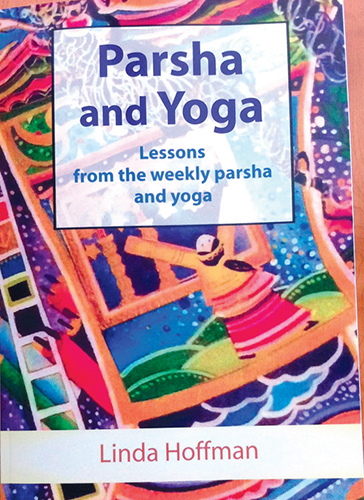
Since my website went live in 2012, I’ve received calls and e-mails from people all over the world, from New York to San Diego, from Canada to Israel, and from England to Brooklyn. (Yes, Brooklyn, can you believe it?!?) Some people come for advice, some visit for support, and some offer business opportunities and ideas for future activities. Each person, however, shares the same goal: to maximize their God-given potential, and to better serve Hashem through optimal health.
It was in this vein, then, that I was sent a book a couple of months ago by Linda Hoffman in Dallas, Texas, titled Parsha and Yoga: Lessons from the Weekly Parsha and Yoga. Linda thought I might be interested in checking it out.
At first glance, when Linda initially reached out to me, I must admit that I thought it was a joke (sorry, Linda); I mean parsha and yoga? Seriously? What does one have to do with the other? I had images in my mind of reciting the psukim in the sedra while straining fiercely in Downward Dog or being contorted in some other tortuous pose. But I’m a big believer in extolling virtues or denigrating faults only after the person or item has been given an opportunity to plead its case; I never proclaim a book is a waste of paper… at least not until after I’ve read it. Anyway, so I was willing to give this book a chance, and I’m glad I did.
The premise of the book is actually quite simple. In Linda’s own words, “we need to protect and care for our body so that we can learn and develop to our highest abilities. We develop our soul by becoming the best “me” that we can be using the tools of the mind and the body that were given to us.”
Having studied yoga for more than 20 years, Linda shares different facets of her art, stating that “yoga is a routine for physical, mental, emotional, and spiritual health; we discover ourselves on all these levels through yoga practice. Yoga enhances the way we live with wisdom, insight, discernment, mindfulness, and acceptance.” Linda also compares the study of yoga with the study of Torah: “Just as we understand Torah at the level of learning we have reached, so we practice our yoga at the level of flexibility and strength of our body.”
The book’s structure comprises short 5-10 minute easy-to-read synopses of each weekly parsha, intertwined with Linda’s own thoughts, as well as various mefarshim and insights. An illustrated simple yoga move with explanatory text can then be found at the end of each parsha outline.
According to Linda, the book is primarily marketed to mid- to late-age women who are less observant, early-stage baalei teshuva, and Reform and Conservative Jews who are interested in incorporating some exercise into their lifestyles. Having said that, however, she tells me that she’s received good responses from people across the “frumkite board,” and, having read the book myself, I see no reason why that shouldn’t be the case.
I found the book to be accessible and fun to read. I found myself strongly agreeing with many of the points that were made, and look forward to practicing much of the advice that was imparted. In fact, in many instances I wished the key points were further elaborated upon, but understand that the author wished to keep each section brief. The summaries of each parsha are concise and colorfully written, mixing biblical narrative with midrashic tales. The yoga poses are well described and illustrated, and are suitable for the beginner; more seasoned yogis, however, may crave more challenging positions. Although there are one or two factual inaccuracies throughout the book, it’s generally well presented and edited.
Personally, rather than exclusively surrounding myself with points of view and hashkafot that I already agree with—thereby bolstering my own ego and ingrained mindset—I try to expose myself to a wide range of attitudes and beliefs outside my comfort zone. Yes, this has the potential to be somewhat detrimental at times, but I believe that is how we grow best—when we’re challenged, physically, intellectually, and spiritually. Reading this book reminded me of how true this notion is. Rather than dismissing this publication as something “not for me,” there were indeed pearls of wisdom buried within its pages.
In her introduction, Linda states that “our mind, our body, and our soul are encompassed in one entity. Our life goal is to be the best “one” that we can be using all of our qualities.” Speaking more broadly, I would add that we, our Nation, should cumulatively strive to be the best “one” that we can be. Each neshama is a conduit from and to Hashem; each has something to offer.
Parsha and yoga? Yes, even parsha and yoga. More often than not, if you don’t see Hashem’s connections in everything around us, the problem isn’t that the dots can’t be joined; it’s more likely that you’re missing some dots in the first place. The key is finding ways to discern and discover the countless dots in this beautiful world.
In describing yoga and its connection to the Torah, Linda writes, “we practice mastery over the physical for the benefit of the mind”… Beautiful… I couldn’t have said it better myself.
Chemmie Sokolic is an ACSM-certified Personal Trainer, and owner of Frum & Fit LLC. Chemmie can be reached at chemmie.sokolic@frumandfit.com. Visit www.FrumandFit.com or www.Facebook.com/FrumandFit for more information.
By Chemmie Sokolic












